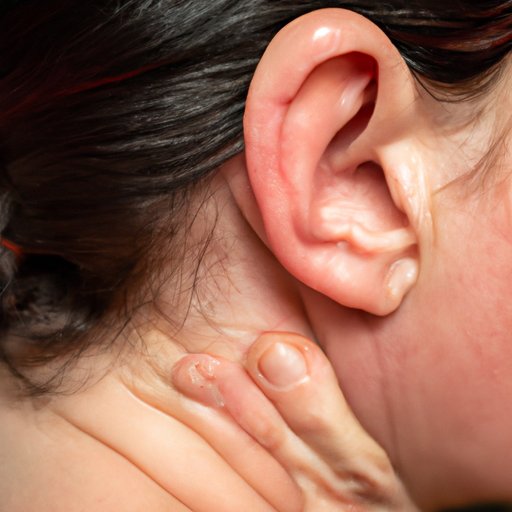
Introduction
If you have ever experienced a clogged ear before, you know how frustrating and uncomfortable it can be. The hearing loss, muffled sounds, and ear pressure can impact daily life by making it difficult to communicate, concentrate, and even sleep. Knowing how to clear a clogged ear can bring immense relief, and this article will explore natural remedies, medications, proper hygiene practices, massaging techniques, and when to seek medical attention.
Natural Remedies for Clearing a Clogged Ear
One of the simplest and most effective ways to clear a clogged ear is to use warm compresses and steam. You can try placing a warm, damp towel over the affected ear or inhaling steam from a bowl of hot water. It’s important to note that these remedies should not be used in extreme temperatures and are not recommended if you have an ear infection or perforated eardrum.
Other natural remedies that can help include using a mixture of hydrogen peroxide and warm water, using a bulb syringe to flush out debris, and using a solution of vinegar, rubbing alcohol, and hydrogen peroxide to dissolve ear wax. It’s important to take precautions when attempting any of these remedies, such as using sterile tools and not forcing anything into the ear canal.
Ear Drops and Over-the-Counter Medications
If natural remedies don’t provide relief, there are a variety of ear drops and medications available over-the-counter that can help. Some common examples include earwax removal drops, decongestants, and antihistamines. These medications work by either softening the earwax or reducing inflammation and fluid buildup in the ear canal.
It’s important to follow the instructions on the packaging carefully and not overuse these medications. Overusing ear drops or using them improperly can result in irritation, hearing loss, or even damage to the ear drum. In addition, some medications may not be safe for individuals with certain medical conditions or who are taking certain medications, so it’s important to discuss their use with a healthcare provider.
Proper Ear Hygiene Practices
One of the best ways to prevent and address clogged ears is to maintain proper ear hygiene. This includes keeping the ears clean and dry, avoiding the insertion of foreign objects like cotton swabs, and avoiding exposure to loud noises and other potential irritants. It’s also important to stay hydrated and to manage allergies and nasal congestion.
If you are prone to clogged ears, you may want to consider investing in earwax removal tools like ear picks or irrigation kits. However, it’s important to use these tools carefully and not force them into the ear canal, as this can lead to injury or infection.
Massaging Techniques to Help Move Ear Wax Buildup
Massaging the ears can be a helpful way to move ear wax buildup out of the canal and improve drainage. This can be done by gently pulling and rubbing the earlobe in a circular motion, or by using your index finger to rub just behind the ear. It’s important to use gentle pressure and to avoid pushing anything deeper into the ear canal.
If you are uncomfortable performing these techniques yourself, you may want to consider seeing an ear, nose, and throat (ENT) specialist or a massage therapist who specializes in ear massages.
When to Seek Medical Attention for a Clogged Ear
While most cases of clogged ears can be addressed with home remedies, there are some red flags to watch out for that may indicate the need for medical attention. These include severe or persistent pain, dizziness or vertigo, pus or discharge from the ear, or a high fever.
In addition, if you have tried multiple home remedies or are experiencing recurrent clogged ears, you may want to consult with a healthcare provider to rule out any underlying medical conditions. A doctor can perform a physical exam and may use specialized tools to remove earwax or address any blockages.
Symptoms of an Ear Infection and How They Differ from a Clogged Ear
In some cases, a clogged ear may not be caused by earwax buildup but rather by an ear infection. It’s important to differentiate between the two conditions, as an ear infection may require antibiotics or other interventions to resolve.
Some common symptoms of an ear infection include ear pain, fever, ear drainage, and difficulty hearing. Additionally, ear infections may be accompanied by other symptoms like sore throat, cough, and nasal congestion.
Tips for Relieving Ear Pressure and Pain While Waiting for the Clog to Clear
While waiting for a clogged ear to clear, there are several simple remedies that can help reduce pain and discomfort. These include using a warm compress, taking over-the-counter pain relievers like ibuprofen or acetaminophen, and avoiding activities like swimming or flying that can aggravate the ear.
It’s important to avoid inserting anything into the ear canal, as this can worsen the clog or cause injury. In addition, if you experience severe or persistent pain, you should consult with a healthcare provider.
Conclusion
Clearing a clogged ear can be a frustrating and uncomfortable experience, but fortunately, there are a variety of remedies and practices that can help. By using natural remedies, over-the-counter medications, proper hygiene practices, and massaging techniques, you can quickly and safely address earwax buildup and clogged ears. If you experience severe or persistent symptoms, it’s important to consult with a healthcare provider to rule out any underlying medical conditions and find the right treatment approach.




